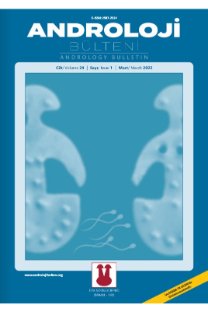Triangulasyon yöntemiyle vazoepididimostomideneyimimiz
AMAÇ: Epididimal obstrüksiyon nedeniyle azoospermi gelişen olgular da, ejakülasyonda sperm elde etmek amacıyla modifiye 2-sütür ile içiçe geçme tekniği kullanarak yaptığımız uç-yan vazoepididimostomininsonuçlarını sunmak. GEREÇ ve YÖNTEMLER: Nisan 2015 ve Temmuz 2018 tarihleri ara sında, epididimal obstrüksiyona bağlı azoospermi tanısıyla mikrocerrahivazoepididimostomi (MVE) yaptığımız altı infertil hastanın verilerinideğerlendirdik. Hastaların altı hafta arayla yapılan iki sperm analizindesemen volümünün ve pH’sının normal olduğu ve azoospermi bulundu ğu teyit edildi. Fizik muayenede testislerden en azından birisi normalvolümde, vaz deferensin intakt ve palpasyonda epididimin ise dolgundu.Plazma FSH düzeyi normal sınırlardaydı. Genel anestezi altında, cerrahimikroskop kullanılarak iki adet çift iğneli 10/0 prolen sütür yardımıy la modifiye iç içe geçme tekniği kullanılarak epididim ile vaz deferensuç-yan anostomoz edildi. İşlem sadece tek taraflı olarak yapıldı ve cer rahi sonrası 1., 3. ve 6. aylardaki sperm parametreleri değerlendirildi.Ejakülatta sperm varlığı anostomoz başarısı olarak kabul edildi. BULGULAR: Hastaların yaş ortalaması 29 (23–44) olup üçünde (%50)epididimal obstrüksiyon geçirilmiş enfeksiyona bağlı iken, bir (%17)hastada çocukluk çağında bilateral hidroselektomi öyküsü vardı. İki(%33) hastada ise etiyoloji tespit edilemedi. Opere edilen toplam altıolgunun üçünde (%50) ejakülatta motil sperm çıkışı sağlandı. Cerrahiyitakiben iki olguda 3. ayda, bir olguda ise 6. aydaki kontrollerinde spermçıkışı olduğu tespit edildi. Ejakülatta çıkan total sperm sayısı ortalama2×106 (1–3,4×106) olup, ortalama motilite %30 (%10–%40) olarakbulundu. Ejakülatta sperm çıkan olgulardan ikisinde etiyoloji enfeksiyo na bağlı iken, birinde idiyopatik idi. SONUÇ: Epididimal obstrüksiyona sekonder azoospermisi bulunan in fertil erkeklerde transvers pozisyonda çift iğneli 2 adet sütür yerleştirile rek iç içe geçme tekniği ile yapılan vazoepididimostomi; teknik kolaylığı,anastomoz sağlamlığı ve erken dönemde sperm çıkışı sağlaması bakı mından güvenilir ve etkili bir teknik olarak görülmüştür. Ancak dahakesin kanıya varmak için daha geniş serilerde ve diğer tekniklerle karşı laştırmalı çalışmalara ihtiyaç olduğu kanısındayız.
Our vasoepididymostomy experience with triangulation method
OBJECTIVE: To present the results of end-to-side vasoepididymostomyperformed with tubular invagination technique by placing 2 double needle sutures to obtain sperm in ejaculation in cases with azoospermiadue to epididymal obstruction. MATERIAL and METHODS: We evaluated the data of 6 infertilepatients who underwent microsurgical vasoepididymostomy (MVE)with the diagnosis of azoospermia due to epididymal obstructionbetween April 2015 and July 2018. It was confirmed that the semenvolume and pH were normal and azoospermia was found in the twosperm analysis performed six weeks apart. Under general anesthesia,an end-to-side anostomosis of the epididymis and the vas deferens wasperformed using a modified tubular invagination technique using 2double-needle 10/0 prolene sutures using a surgical microscope. Thesperm parameters at 1, 3 and 6 months after surgery were evaluated.The presence of sperm in the ejaculate was considered an anostomosissuccess. RESULTS: The mean age of the patients was 29 (23–44). Motile spermwere obtained in the ejaculate in 3 (50%) of 6 patients who underwentMVE. Sperm were obtained in 3 months postoperatively in 2 patientsand in 6 months postoperatively in one patient. The mean total spermcount obtained from the ejaculate 2×106 (1–3.4×106), and the meanmotility was found to be 30% (10%–40%). While the etiology wasrelated to infection in two of the cases where sperm was obtained fromthe ejaculate, one was idiopathic. CONCLUSION: Vasoepididymostomy performed with tubularinvagination technique by placing 2 double-needle sutures in transverseposition in infertile men with azoospermia secondary to epididymalobstruction; It has been seen as a safety and effective technique in termsof technical ease, anastomosis stability and providing sperm retrieval inthe early period. However, we think that studies in larger series andcomparative studies with other techniques are needed to reach a moredefinite conclusion.
___
- 1. Wosnitzer M, Goldstein M, Hardy MP. Review of azoospermia. Spermatogenesis 2014;4:e28218. [CrossRef]
- 2. McDougal WS, Wein AJ, Kavoussi LR, Partin AW, Peters CA. Campbell-Walsh Urology, 11th ed. Review E-Book: Elsevier Health Sciences; 2015.
- 3. Schrepferman CG, Carson MR, Sparks AE, Sandlow JI. Need for sperm retrieval and cryopreservation at vasectomy reversal. J Urol 2001;166:1787–9. [CrossRef]
- 4. Goldstein M, Tanrikut C. Microsurgical management of male infertility. Nat Clin Pract Urol 2006;3:381–91. [CrossRef]
- 5. Thomas Jr A. Vasoepididymostomy. Urol Clin North Am 1987;14:527–38. [CrossRef]
- 6. Berger RE. Triangulation end-to-side vasoepididymostomy. J Urol 1998;159:1951–3. [CrossRef]
- 7. Wallach E, Silber SJ. Vasectomy and vasectomy reversal. Fertil Steril 1978;29:125–40. [CrossRef]
- 8. Marmar JL. Modified vasoepididymostomy with simultaneous double needle placement, tubulotomy and tubular invagination. J Urol 2000;163:483–6. [CrossRef]
- 9. Stefanovic KB, Clark SA, Buncke HJ. Microsurgical epididymovasostomy by tubule intussusception: a new technique in rat model. Fertil Steril 1991;55:189–93. [CrossRef]
- 10. Schiff J, Chan P, Li PS, Finkelberg S, Goldstein M. Outcome and late failures compared in 4 techniques of microsurgical vasoepididymostomy in 153 consecutive men. J Urol 2005;174:651–5. [CrossRef]
- 11. Binsaleh S. Two-suture single-armed longitudinal intussusception vasoepididymostomy for obstructive azoospermia: report of patients characteristics and outcome. Int Urol Nephrol 2014;46:2271–7. [CrossRef]
- 12. Zhao L, Deng C-H, Sun X-Z, Chen Y, Wang W-W, Zhao L-Y, et al. A modified single-armed technique for microsurgical vasoepididymostomy. Asian J Androl 2013;15:79–82. [CrossRef]
- 13. Shekarriz M, Pomer S. Microsurgical vasoepididymostomy: a comparison between the end-to-side anastomosis and the invagination technique. Urol Res 1991;19:285–7. [CrossRef]
- 14. Farber NJ, Flannigan R, Li P, Li PS, Goldstein M. The kinetics of sperm return and late failure following vasovasostomy or vasoepididymostomy: a systematic review. J Urol 2019;201:241– 50. [CrossRef]
- 15. Shiraishi K, Matsuyama H. Outcomes of partial intussusception and endo‐to‐side vasoepididymostomy in men with epididymal obstructive azoospermia. Int J Urol 2020;27:1124–9. [CrossRef]
- ISSN: 2587-2524
- Yayın Aralığı: Yılda 4 Sayı
- Başlangıç: 1999
- Yayıncı: Turgay Arık
Sayıdaki Diğer Makaleler
Genç kadınların perspektifinden cinsel sağlık veüreme sağlığında damgalama
Pınar Irmak VURAL, Nazife BAKIR, Cuma DEMİR
Triangulasyon yöntemiyle vazoepididimostomideneyimimiz
Erkek infertilitesinde tamamlayıcı tıp uygulamaları:Kanıt düzeyi nedir?
Coşkun KAÇAĞAN, Halil Lütfi CANAT
Stomalı hastaların yaşadıkları cinsel sorunlar:Sistematik çalışma
Meme kanseri cerrahisi geçiren kadınların bedenimajı ve cinsel uyumları
Muhammed Arif İBİŞ, Kaan AYDOS
PDE5 inhibitörlerinin etkinliğinin optimize edilmesi
Postpartum dönemde cinsel sağlık ve danışmanlık:BETTER modeli kullanımı
